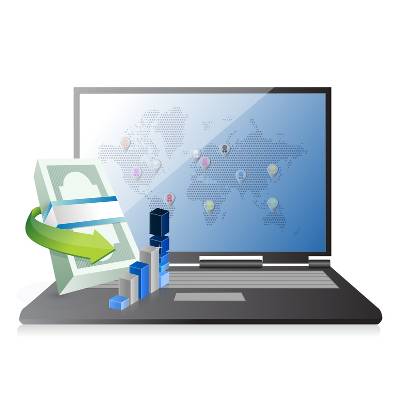Running a business can be tough and result in a lot of frustration from staff, management, and customers. Sometimes that frustration can boil over and cause consternation among the core elements that need to function for a business to be successful. This week, let’s look at an issue that can really hurt your business.
Directive Blogs
Sure, retailers have to manage their inventory effectively, but have you ever thought about the way your own business manages what it keeps on hand? Today we want to discuss five ways your business can more effectively manage inventory—and it turns out technology plays a pretty significant part in improving any inventory control system.
One way businesses attempt to save money is through automating certain processes and tasks that have traditionally been time-consuming or monotonous for their workforce. When implemented appropriately, automation can cut costs, streamline operations, and improve quality of life for workers. However, just because a task can be automated doesn’t necessarily mean that it should be automated. Let’s look at the arguments for and against automation in these contexts.
For business managers, it can sometimes be difficult to create policies and procedures that allow for the efficiency that they’d like to see from their business. Business growth leads to more complex situations which in turn demand more complex procedures. This enhanced complexity can not only get constant in that you need to alter the way things are done, you also could fall into the trap of mistakenly putting productivity roadblocks up that can alter the way your business operates.
Lots of businesses are facing a financial crunch as the margins they operate under continue to shrink. This unfortunate trend has led a lot of businesses to outsource elements of their operations to try and cut costs. One part of the business that is either outsourced or cut out entirely has been the human resources department.
Cyberattacks are a serious problem that all businesses face in some form or another, but there are small, everyday tasks you can do to ensure that they impact your organization as minimally as possible. It takes intention and effort to protect your business and its infrastructure, but that doesn’t mean that it has to be hard. Here are three simple ways you can keep your infrastructure secure.
All successful businesses want to grow and better themselves, as growth is a direct indicator that you are doing something right, from providing better services to your customers or servicing more customers. If you’re not ready to adapt to this growth, you’re in for a difficult time. Here are three ways you can keep your business operating even when you’re experiencing unprecedented growth.
There are countless moving parts to any successful business, and smaller companies often have the issue of their employees juggling multiple different tasks and wearing all kinds of different hats in addition to their outlined job duties and responsibilities. You might encounter situations where you don’t know what to do, and it can be overwhelming when so much needs to get done in so little time.
Technology advances at an incredible rate, and the successful business has much work to do in order to keep up with it. How does your organization’s ability to change and adapt hold up compared to your competitors? This concept, dubbed business agility, is of critical importance in today’s fast-paced business environment, and if you aren’t prepared to assess it, you might be falling behind the competition.
Your business’ technology is a great tool, or at least it can be. Like any other part of business, getting value out of your business’ technology is essential. In order for you to see the kind of value from your tech that you’d expect, you first need to approach it by making good decisions. This month, we wanted to go over a few ways that you could fall into a trap with your IT.
It might be an understatement to suggest that things don’t always go smoothly in business. The truth is that when one problem is solved, another is often created. This is why we lean on our technology. These “solutions” are intended to fix many of the speedbumps, but that doesn’t mean that choosing, deploying, and supporting these systems don’t come with some problems as well. Today, we look at three reasons an IT project could fail.
Running a business can be stressful, and if you can’t find time to juggle the countless variables that are at play every day of the week, you’ll quickly find yourself falling behind what needs to be done. Technology is one such area where falling behind is easy, especially when it comes to purchasing and implementing new tools. Unfortunately, your IT budget is not limitless, so how can you make the most of it? Let’s take a look.
We all know the importance of IT maintenance and management when it comes to effectively running a business, but it’s really hard to ensure that your technology is being properly maintained when your staff have one foot out the door. A new survey from Gartner suggests that IT employees are more likely to leave your business than other non-IT employees, and this puts a heavier burden on you to make sure technology is properly taken care of.
The COVID-19 pandemic is still in full swing, and while many companies buckled under the pressure put on them to maintain operations, others have managed to adapt through the use of remote technology solutions. Businesses have put into place policies surrounding this remote technology, many of which are both helpful and harmful.
Ever since employees began returning to the office after getting a taste of remote work, there has been an ongoing war between employers wishing a return to normalcy and the employees who would rather get their work done from the comforts of their own home. Now, a new survey indicates that half of employees would rather quit than deal with an employer who mandates a return to the office environment.
When considering a continuity plan for your business, you need to consider some scenarios that may not ever happen. This is called risk management and it is the basis of keeping your business up and running regardless of the situations that it encounters. This month, we thought we would outline some of the variables that need to be addressed when creating a comprehensive business continuity plan.
When was the last time that you took a hard look at your business’ technology? How old are some of the devices that you rely on each day? These are critical questions to answer if you want your business to succeed. Let’s discuss why upgrading is so important, and how to determine when the time to upgrade comes.
The process of implementing new technology for your business can be a tiresome, frustrating, and confusing process. This is especially the case when you implement a new technology solution only to find that it was absolutely not worth the effort. Let’s take a look at some of the reasons why your IT project deployment might not go according to plan, as well as how you can make sure this does not happen for your company.
Security can be tough for small businesses to optimize, but that does not make it any less important. One such way that security can work against you is actually your employees’ predispositions toward it; the cognitive biases that your employees have regarding security can put your company at risk, even if that is the last thing on their minds.
Technology is such a wonderful tool for productivity, but one thing that you need to understand is that it cannot work miracles. At the end of the day, we are all still human; distractions creep in that technology cannot prevent. Some users struggle with staying focused, which in turn leads to unproductive behaviors, all of which compounds to create wasted time and money. Let’s discuss some ways that your employees can overcome distractions in the workplace.
Businesses use technology to varying degrees, but even small businesses have a lot of technology that must be tracked on a daily basis. With so many devices floating around the office, how are you making sure that you know who has which device, when it was issued, and how it’s being used? We suppose the question is not “how” you are keeping track of it all, but “if.” For this task, we recommend implementing an inventory tracking system for your business’ technological assets.
Making solid business decisions can sometimes be confusing. Not that you try to make anything other than good decisions, but a lot of business is, and has always been, trial and error; and, you may know this from experience, error happens to be a big part of it. Today, we thought we would discuss what goes into good technology decisions and how many times it comes down to the results.
There is no question that the COVID-19 pandemic has had no small impact on the way that business is conducted. A considerable part of that impact is directed toward the technology that powers these businesses. One way or another, the way that businesses use their technology is bound to be influenced before all this is over.
For the months that COVID-19 has been around, everyone has done all they can to hold on to their business. They have closed down, they have closed their offices and forced their employees to work from home, they have borrowed money and scaled back or eliminated their 2020 plans. It would be nice if all that sacrifice would pay off, but the frustrating reality is that there is going to be a lot of sustained discomfort for a lot of business owners. Let’s take a look at some things small business owners should consider as they reopen their businesses.
How many times have you gone to the store and bought something that you already had? Unfortunately, this happens all the time, but fortunately it’s usually a half gallon of milk or a loaf of bread. When it happens in your business, it can be much more expensive. Today, we will advocate for an inventory strategy that will keep you from spending wads of cash on redundant investments.
If you’re in business today, there are three words that are critical for you keep in mind: Cybersecurity. Is. Important. As such, every business needs to have taken the time to put together a cybersecurity policy--a set of guidelines that instruct the business how to proceed with the highest level of security possible. We’ve taken the liberty of suggesting a few guidelines for your business to follow as you do so.
With most businesses looking to control costs, their decision makers need to find innovative new ways to do business. One way that many firms can increase productivity without raising costs is to promote a culture of collaboration. Today, we’ll take a look at some of the useful technology that businesses can leverage to improve their output.
It isn’t uncommon for business owners to keep their knowledge close to the chest, hesitant to share what some might consider valuable proprietary information with their staff or - heaven forbid - their clients. While we agree that you shouldn’t necessarily overshare with your clients, your staff needs to have access to some information in order to do their jobs
Generation Y (or Millennials, as they are more commonly known) have a rough reputation in the business world. Whether they’re being blamed for the death of entire industries or mocked for their fondness for avocado toast, it isn’t often that millennials are taken seriously - especially in the workplace. However, if nurtured correctly, this group has the potential to produce some of your top performers. Here, we’ll get into how to do so.
There aren’t many happier moments for a person than when they score their first big job. The opportunity to use the skills they have learned, and to pay off some of the debt that knowledge set them back, are two activities most people who are in this position relish. However, you can’t expect these opportunities to keep your employees around forever... you need to meet (and sometimes manage) their other expectations of the workplace.
The way that an organization handles risk is a big deal. Despite being born out of opportunity, opening a business itself can be looked on by many a major risk. As a result, every business should be looking to manage their risk. Today, we take a look at the role risk plays in business, and how IT, for all its benefits, carries with it some risk.
In order to build a profitable business, productivity has to remain consistent. If your business offers a service, and you are having a hard time managing all its moving parts, professional services automation (PSA) software may be right for you. Today, we will give a quick overview of what exactly a PSA is, and how it can serve as an extremely useful tool for businesses who operate in the professional services space.
Chances are that if you are a business owner that has been in business for a decade you’ve seen how emerging technologies have changed the face of business. Technologies like cloud computing have opened up opportunities for many businesses to get the powerful computing infrastructures they need without massive upfront costs. As this trend continues, the IT services has begun to move past core IT management and support and onto providing real solutions for the modern business. Today, we will look at how the Managed Service Provider (MSP) is at the forefront of a data revolution that has no end in sight.
Business technology continues to grow in importance for the small and medium-sized business, especially as many prepare for 2019. Where enterprise-level companies have long been using technology to bring people together and drive overall productivity, many SMBs are new to these opportunities. The availability of cloud resources, coupled with shifts in security, mobility, and other core technologies, makes it important for every organization, no matter what size, to have a comprehensive technology strategy.
As a business adopts certain “best practices,” it is important for business leaders to consider why they are adopted, and more importantly, are they really for the best? There are many problems that subscribing to false best practices can produce, and so it becomes important to identify, adjust, and resolve them.
Entrepreneurs enjoy an almost mythical standing in the business world as visionary leaders risking everything on an idea that, if successful, pays off in a big way. Yet, few understand the role of the intrapreneur; those who have equally big ideas, but operate in the context of established companies. Your business likely has dynamic intrapreneurs in your midst, but how do you make sure their voices are heard?
How many emails does your organization receive every day? Chances are that you can’t find time in your day-to-day operations to maintain and manage your email solution as well as you’d like, and in a world where threats to your organization’s network lurk around every corner, you can never be too careful. How can you make sure that you’re taking proper care of your business’s email infrastructure, without sacrificing the time and manpower required to do so?
Vince Lombardi, one of the most successful head coaches in NFL history, once said “If you are five minutes early, you are already ten minutes late.” Although it wasn’t its intended use, this quotation can easily apply to technology. The tech industry is constantly changing, improving, and innovating. Adapting to changes is something all businesses must do to thrive, small and medium businesses included.
While many different people open businesses, the primary reason that they all do so is to make money. A positive cash flow is essential if the business is to generate funds that support a cause or provide a decent living. However, to collect this cash flow, a business must have their invoices returned. As it happens, this doesn’t often occur in a timely manner.
Your business either has a sound plan to manage its IT maintenance, or it does not. There is no middle ground here. Either you have an internal team dedicated to maintaining your IT infrastructure, or it’s not being taken care of as well as it should be. Even if you do have an internal team, you might notice that they simply don’t have time on their hands to handle all of their responsibilities. We’re here to introduce you to one of the most notable ways of keeping your technology in proper working order: managed IT services.
Technology has become more commonplace in offices and homes all around the world, and you might find yourself replacing it more often than previously thought. This leads to an awful lot of waste that can accumulate in your office, be it an extra smartphone, desktop, or something as simple as a random, non-functional hard drive. However, getting rid of your old, unnecessary tech isn’t as simple as throwing paper into a recycling bin, and it shows in the amount of e-waste that infects the world every day.
An IT project manager is an important part of any new technology initiative in your workplace. Therefore, you should be looking for specific requirements when finding a project manager for your latest project implementation. Here are some specific traits that your business should look for in an IT project manager.
2017 was filled with security issues ranging from threats and small attacks to major security breaches. You can learn a lot from the misfortunes of other ill-prepared organizations about how to prepare for and handle cybersecurity issues. This week’s tip is dedicated to learning a bit from some of the security problems that may have flown over your radar last year.
It’s no secret that a business owner has more than enough to deal with, regardless of that business’ size.
Whether the business has 10 employees or 100, the business owner has to deal with the stress of managing the minutiae of everyday operations, along with any other issues that may pop up. As one might assume, financial concerns can contribute considerably to that stress.
Any project manager will tell you that there are countless issues that can get in the way of a successful implementation. To nobody’s surprise, business technology can aid project management by streamlining operations and making the entire process much easier for everyone involved. We’ll dig into the details about how project management software and value-based managed IT services can help you complete projects on-time and on-budget.
The office is a workplace, so it most likely isn’t a place that is often associated with fun and games. However, different aspects of games have been shown to provide significant benefits when introduced into the professional environment. Today, we’ll explore some of the ways that a little frivolity may benefit your office.
You are an expert in your field, right? Whether you sell a product or commit to a batch of service offerings, you know your job and you know it well. We're guessing you have some great employees who know their job well too, right? You hired them because of their drive, interest, and possibly knowledge in the field (or you spend plenty of time teaching and training them). So when someone's computer goes down, why should they waste their time trying to fix it?
 We've all been there; dealing with long, annoying tech support, hoping to make that extended warranty worth while. Should you eventually speak to a human, you run the risk of running smack into a language barrier. Then, there is always the inevitable 'Did you turn off your computer and turn it back on?' Would you really be still on hold if you hadn't tried everything you could think of?
We've all been there; dealing with long, annoying tech support, hoping to make that extended warranty worth while. Should you eventually speak to a human, you run the risk of running smack into a language barrier. Then, there is always the inevitable 'Did you turn off your computer and turn it back on?' Would you really be still on hold if you hadn't tried everything you could think of?
As a business owner, if you've ever looked into training seminars, you've probably been taken back by the price. Your industry likely has a whole slew of organizations dedicated to business training, and there are often training courses on specific software packages you use in your day-to-day line of business. Your employees may know full-well how to do their job, but are they doing it as effectively as possible in order to drive business forward?
 Nature can be pretty impressive. It can interrupt the day-to-day operations of businesses, cause major damage, and cost your business in expensive downtime. Having a good business continuity plan (and ensuring you have it set in place) can make or break your company when mother nature comes knocking at your door.
Nature can be pretty impressive. It can interrupt the day-to-day operations of businesses, cause major damage, and cost your business in expensive downtime. Having a good business continuity plan (and ensuring you have it set in place) can make or break your company when mother nature comes knocking at your door.
 Are you looking for a new computer service provider? Deciding on a company to handle your technology is a choice that carries a little more weight than let's say, switching your cable provider. You are essentially giving this new computer company access to all of your company's sensitive information. No pressure!
Are you looking for a new computer service provider? Deciding on a company to handle your technology is a choice that carries a little more weight than let's say, switching your cable provider. You are essentially giving this new computer company access to all of your company's sensitive information. No pressure!
 As technology keeps leading us into the future, it can be easy to lose sight of traditional leadership methods. Since the newest gadgets are so appealing, it's tempting to have technology automate our decision making as a crutch. Can technology really replace the old school business leadership practices?
As technology keeps leading us into the future, it can be easy to lose sight of traditional leadership methods. Since the newest gadgets are so appealing, it's tempting to have technology automate our decision making as a crutch. Can technology really replace the old school business leadership practices?
You’ve probably noticed that when you search for a particular business using words like or similar to “near me,” Google will display three business options at the top of your search results, and then will load additional businesses once you click “More places.” Remember - people in your area that are looking for a business like yours will probably be doing exactly that. How can you make sure you are in those top three results?
The modern small business will face several challenges in 2018. The world is changing, and with it, so is business. For many small businesses, this can either be looked on as the opportunity they’ve been waiting for, or, it can be viewed as the beginning of the end. No matter what situations you are faced with this year, understanding what problems your business faces, and how to solve them is imperative to your small business’ success.
Internal communications are remarkably important for a business with multiple moving parts. In a world with many choices for communication, how does your company keep in touch? We’ve put together five great ways that your company can take advantage of today’s networking technology to create an infrastructure meant to help your employees stay connected to one another and promote organizational cooperation.
 Regardless of how your business’s administration is set up, you should be aware that anyone in a position of authority must have a basic understanding of how IT, and its related responsibilities, functions for your business. Here are four ways that you can learn more about how IT works within your organization.
Regardless of how your business’s administration is set up, you should be aware that anyone in a position of authority must have a basic understanding of how IT, and its related responsibilities, functions for your business. Here are four ways that you can learn more about how IT works within your organization.
 As a business owner, you walk a fine line between boss and friend. While you want to be approachable and have a company culture that’s friendly, you can’t have your employees be your closest friends. Being too close to your staff will blur your authority, breed favoritism, and make it difficult to fire people; but not being friendly will make for a cold working environment. How do you manage this social dynamic?
As a business owner, you walk a fine line between boss and friend. While you want to be approachable and have a company culture that’s friendly, you can’t have your employees be your closest friends. Being too close to your staff will blur your authority, breed favoritism, and make it difficult to fire people; but not being friendly will make for a cold working environment. How do you manage this social dynamic?
 Business owners primarily concentrate more on the digital effects of hacking rather than the physical side of it. After all, hacking some code through a network can’t harm you or anybody else in the real world, right? Wrong. As shown by a recent hack in Germany, ignoring network security can be a dangerous gambit.
Business owners primarily concentrate more on the digital effects of hacking rather than the physical side of it. After all, hacking some code through a network can’t harm you or anybody else in the real world, right? Wrong. As shown by a recent hack in Germany, ignoring network security can be a dangerous gambit.
 If you’re looking to save some money on IT, outsourcing your company’s IT services is a simple and effective method. This concept has grown tremendously over the past several years, and the saved expenses are one of its biggest attractions. However, businesses sometimes decide that it might be time to backsource their IT.
If you’re looking to save some money on IT, outsourcing your company’s IT services is a simple and effective method. This concept has grown tremendously over the past several years, and the saved expenses are one of its biggest attractions. However, businesses sometimes decide that it might be time to backsource their IT.
 We offer a handy IT service called vendor management. This is where we resolve technology issues on behalf of your business by coordinating with vendors to provide a fix, even if it lies outside the realms of our expertise. You may not realize it, but you actually use vendor management services for other everyday aspects of your life.
We offer a handy IT service called vendor management. This is where we resolve technology issues on behalf of your business by coordinating with vendors to provide a fix, even if it lies outside the realms of our expertise. You may not realize it, but you actually use vendor management services for other everyday aspects of your life.
 Can you tell the difference between the two words, Internet and Intranet? The difference is much more than simply two letters. Both are valuable marketing tools, particularly for small businesses, but what exactly differentiates them from each other? The key to understanding this is a simple English lesson.
Can you tell the difference between the two words, Internet and Intranet? The difference is much more than simply two letters. Both are valuable marketing tools, particularly for small businesses, but what exactly differentiates them from each other? The key to understanding this is a simple English lesson.
 Trivia time! Do you know what device was invented in 1892 that changed the face of offices around the world? If you guessed the fax machine then you're close, but you need to think further ahead by almost 50 years (the first fax machine was patented in 1843 by Alexander Bain). More influential than even the fax machine is the file cabinet, established in 1892.
Trivia time! Do you know what device was invented in 1892 that changed the face of offices around the world? If you guessed the fax machine then you're close, but you need to think further ahead by almost 50 years (the first fax machine was patented in 1843 by Alexander Bain). More influential than even the fax machine is the file cabinet, established in 1892.
 It's no surprise that technology is taking over our lives. It's everywhere; from the workplace to every inch of our homes, new technology exists where it wouldn't have twenty years ago. Bluetooth-connected kitchen appliances allow their owners to turn them on and off from a distance. Cars can connect to the Internet. Google has produced glasses that allow you to browse the Internet. There are tons of innovative, new inventions that have had a huge impact on the way small business owners manage their workplaces, but nothing can compare to the significance of being able to receive text files from anywhere in the world via email and fax.
It's no surprise that technology is taking over our lives. It's everywhere; from the workplace to every inch of our homes, new technology exists where it wouldn't have twenty years ago. Bluetooth-connected kitchen appliances allow their owners to turn them on and off from a distance. Cars can connect to the Internet. Google has produced glasses that allow you to browse the Internet. There are tons of innovative, new inventions that have had a huge impact on the way small business owners manage their workplaces, but nothing can compare to the significance of being able to receive text files from anywhere in the world via email and fax.
 Just because you have an IT technician on staff, doesn't mean your technology needs are 100% covered. The people making up your IT department are just that, people, and because they are people, having reliable coverage can be difficult. Outsourcing your IT department is the perfect way to get the extra coverage your business needs, especially when your IT team can't be there for you.
Just because you have an IT technician on staff, doesn't mean your technology needs are 100% covered. The people making up your IT department are just that, people, and because they are people, having reliable coverage can be difficult. Outsourcing your IT department is the perfect way to get the extra coverage your business needs, especially when your IT team can't be there for you.
 Whenever you hire a new employee, you essentially incorporate their social network into the networking reach of your business. With this reality in mind (along with the measurable influence of an employee's use of social media) you have to ask yourself, "Is a connected employee more valuable than a non-connected employee?"
Whenever you hire a new employee, you essentially incorporate their social network into the networking reach of your business. With this reality in mind (along with the measurable influence of an employee's use of social media) you have to ask yourself, "Is a connected employee more valuable than a non-connected employee?"
 As the top American collegiate men's and women's basketball teams are poised to take the court to decide national champions in 2014 NCAA tournament, local businesses are in a competition of their own; to turn a profit. There are three ways your business and your favorite team share a similar path to success.
As the top American collegiate men's and women's basketball teams are poised to take the court to decide national champions in 2014 NCAA tournament, local businesses are in a competition of their own; to turn a profit. There are three ways your business and your favorite team share a similar path to success.
 One of the best ways to leverage technology in order to make your business more profitable is to take advantage of the latest trends. 2014 presents business owners with dynamic new trends that are improving operations and providing the competitive edge. Over the next week we will highlight three of the most important trends that your business can take advantage of, beginning with Business Intelligence Analytics.
One of the best ways to leverage technology in order to make your business more profitable is to take advantage of the latest trends. 2014 presents business owners with dynamic new trends that are improving operations and providing the competitive edge. Over the next week we will highlight three of the most important trends that your business can take advantage of, beginning with Business Intelligence Analytics.
 If you've never taken advantage of remote support to remedy an IT problem, then you're likely doing IT support the hard way by having a technician physically take care of every issue. While it's always nice to chat with your friendly tech, you may be able to save yourself a whole lot of time and money by taking care of the issue with remote support.
If you've never taken advantage of remote support to remedy an IT problem, then you're likely doing IT support the hard way by having a technician physically take care of every issue. While it's always nice to chat with your friendly tech, you may be able to save yourself a whole lot of time and money by taking care of the issue with remote support.
 Language is one of the biggest contributors to determining office culture. For example, a workplace where the management motivates with threats will be a completely different environment than an office where encouragement is liberally applied. The allowance or forbiddance of swearing is another major indicator of your company's culture. How does the language in your office reflect your company's values?
Language is one of the biggest contributors to determining office culture. For example, a workplace where the management motivates with threats will be a completely different environment than an office where encouragement is liberally applied. The allowance or forbiddance of swearing is another major indicator of your company's culture. How does the language in your office reflect your company's values?
 The importance of backing up your company's data cannot be stressed enough. Data is your business' most valuable asset, as evidenced by the fact that companies unable to access their data for ten days after a major disaster (like Hurricane Sandy that hit the mid atlantic and northeast U.S) will not survive the next fiscal year. Here's how to protect your business with data backup.
The importance of backing up your company's data cannot be stressed enough. Data is your business' most valuable asset, as evidenced by the fact that companies unable to access their data for ten days after a major disaster (like Hurricane Sandy that hit the mid atlantic and northeast U.S) will not survive the next fiscal year. Here's how to protect your business with data backup.
 Thanks to cloud computing technology, many businesses are taking advantage of having a mobile workforce by allowing their staff to work from home. Working from home can be beneficial by making workers more productive, saving employees' time and money from commuting, and increasing worker satisfaction, but how can you know for sure if work is really getting done?
Thanks to cloud computing technology, many businesses are taking advantage of having a mobile workforce by allowing their staff to work from home. Working from home can be beneficial by making workers more productive, saving employees' time and money from commuting, and increasing worker satisfaction, but how can you know for sure if work is really getting done?
 Have you been frustrated with your employees lately? Maybe they aren't getting projects done on time, or aren't producing at a very high quality. Have you ever considered that you have substantial control over their job performance? People only work if they are motivated to do so. Here are six ways to motivate your employees.
Have you been frustrated with your employees lately? Maybe they aren't getting projects done on time, or aren't producing at a very high quality. Have you ever considered that you have substantial control over their job performance? People only work if they are motivated to do so. Here are six ways to motivate your employees.
 As your company grows and enters into more competitive markets, your ability to access reliable and accurate data is of the utmost importance. Ginni Rometty; CEO, president, and chair of IBM, shared her insight on data management in her speech on October 2nd at the IBM InterConnect 2013 event. Here are three benefits of successful data management according to Rometty.
As your company grows and enters into more competitive markets, your ability to access reliable and accurate data is of the utmost importance. Ginni Rometty; CEO, president, and chair of IBM, shared her insight on data management in her speech on October 2nd at the IBM InterConnect 2013 event. Here are three benefits of successful data management according to Rometty.
 If your business has never experienced a major computer problem, then it's easy to underestimate just how damaging downtime can be. This conclusion can be drawn from a recent survey of small business owners, where 65% estimated they would only lose $500 if their company's network went down for a day. In reality, downtime is much more costly than $500.
If your business has never experienced a major computer problem, then it's easy to underestimate just how damaging downtime can be. This conclusion can be drawn from a recent survey of small business owners, where 65% estimated they would only lose $500 if their company's network went down for a day. In reality, downtime is much more costly than $500.
 The way you treat customers, handle their feedback, and serve their needs can be the most powerful selling point of your business. Customer satisfaction comes down to the way customers feel after they've made a purchase. Your customer service policy can either make or break your business. Here's how to bulletproof your customer service policy.
The way you treat customers, handle their feedback, and serve their needs can be the most powerful selling point of your business. Customer satisfaction comes down to the way customers feel after they've made a purchase. Your customer service policy can either make or break your business. Here's how to bulletproof your customer service policy.
 What would happen if your business experienced a disaster and your sensitive information was erased? If you don't have a business continuity plan in place that includes data backup and recovery, then it's highly unlikely your company will survive. To protect your business, you will want to consider and choose one of these three backup solutions.
What would happen if your business experienced a disaster and your sensitive information was erased? If you don't have a business continuity plan in place that includes data backup and recovery, then it's highly unlikely your company will survive. To protect your business, you will want to consider and choose one of these three backup solutions.
 In a recent survey of small businesses, only 13% of respondents believed themselves to be susceptible to a disaster resulting in data loss. That means 87% of small businesses must be located in a fortress where they are protected from every natural disaster--yeah right! No business is immune from disaster; therefore, every company needs a disaster plan.
In a recent survey of small businesses, only 13% of respondents believed themselves to be susceptible to a disaster resulting in data loss. That means 87% of small businesses must be located in a fortress where they are protected from every natural disaster--yeah right! No business is immune from disaster; therefore, every company needs a disaster plan.
 The latest trend in business technology is employees bringing in their personal devices to work. This trend is commonly referred to as BYOD (Bring Your Own Device), and it's presenting businesses with both new opportunities and challenges. We will breakdown BYOD into 2 parts; benefits and risks. In part 1, we will look at five benefits of BYOD.
The latest trend in business technology is employees bringing in their personal devices to work. This trend is commonly referred to as BYOD (Bring Your Own Device), and it's presenting businesses with both new opportunities and challenges. We will breakdown BYOD into 2 parts; benefits and risks. In part 1, we will look at five benefits of BYOD.
 When your network's security is doing its job and keeping your business safe, it's easy to not think about it because you don't feel the heat from any threats. Just because you're not feeling the heat, however, doesn't mean you're out of the kitchen. Even if you enjoy strong security, you will still need to perform regular security maintenances.
When your network's security is doing its job and keeping your business safe, it's easy to not think about it because you don't feel the heat from any threats. Just because you're not feeling the heat, however, doesn't mean you're out of the kitchen. Even if you enjoy strong security, you will still need to perform regular security maintenances.
 Backing up your company's data is critical when it comes to keeping operations going after a disaster. Data backup is an important operating expense that you can't afford to skip out on, but if you're looking to cut back on the cost of your data backup service, then you should consider the 80/20 Rule.
Backing up your company's data is critical when it comes to keeping operations going after a disaster. Data backup is an important operating expense that you can't afford to skip out on, but if you're looking to cut back on the cost of your data backup service, then you should consider the 80/20 Rule.
 It's convenient to have an in-house IT technician. If your computer freezes up, you can call the IT department and they will swoop in and save the day. This is how in-house IT is supposed to work, but it's hard to hire anyone that's 100% reliable. We think it's actually more advantageous to outsource your IT; here are 5 reasons why.
It's convenient to have an in-house IT technician. If your computer freezes up, you can call the IT department and they will swoop in and save the day. This is how in-house IT is supposed to work, but it's hard to hire anyone that's 100% reliable. We think it's actually more advantageous to outsource your IT; here are 5 reasons why.










